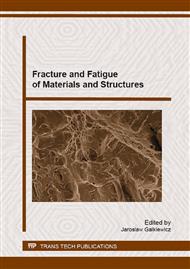[1]
Achtelik H., Lachowicz C., Lagoda T., Macha E. (1997).
Google Scholar
[2]
Boller C., Seeger T. (1987), Materials Data for Cyclic Loading, Materials Science, Monographs, 42, Elsevier Publisher.
Google Scholar
[3]
Manson S.S., Muralidharan U. (1987) Fatigue life prediction in bending from axial fatigue information, Fatigue & Fracture Engineering Materials & Structures, Vol. 9, No. 5, 357-372.
DOI: 10.1111/j.1460-2695.1987.tb00462.x
Google Scholar
[4]
Kandil F.A. (2000), The Determination of Uncertainties in Low Cycle Fatigue Testing, Standards Measurement & Testing Project No. SMT4-CT97-2165, Issue 1, 1-26.
Google Scholar
[5]
Gorash Y., Chen H. (2013), On creep-fatigue endurance of TIG-dressed weldments using the linear matching method, Enineering Failure Analysis, Vol. 34, 308-323.
DOI: 10.1016/j.engfailanal.2013.08.009
Google Scholar
[6]
Marcisz E., Nieslony A., Lagoda T. (2012), Concept of fatigue for determining characteristics of materials with strengthening, Material Science Forum, Vol. 726, 43-48.
DOI: 10.4028/www.scientific.net/msf.726.43
Google Scholar
[7]
Langer B.F. (1962), Design of Pressure Vessels for Low-Cycle Fatigue, ASME Journal of Basic Engineering, Vol. 84, 389-402.
DOI: 10.1115/1.3657336
Google Scholar
[8]
Manson S. S (1979), Inversion of the strain-life and strain-stress relationships for use in metal fatigue analysis, Fatigue of Engineering Matarials and Structures, Vol. 1, 37-57.
DOI: 10.1111/j.1460-2695.1979.tb00366.x
Google Scholar
[9]
Manson S.S. (1965), Fatigue: A complex subject-some simple approximations, Experimental Mechanics, Vol. 5(4), 193-226.
Google Scholar
[10]
Chopra O.K. (1998), Effects of LWR coolant environments of fatigue design curves of austenitic stainless steels, U.S. Nuclear Regulatory Commission, NUREG/CR-5704, ANL-98/31.
DOI: 10.2172/505402
Google Scholar
[11]
Troschenko V. (1996), High-cycle fatigue and Inelasticity of Metals, Multiaxial and Fatigue Design, ESIS 21, (Edited by A. Pinueau, G. Cailletaud and T. C . Lindley), Mechanical Engineering Publications, London, 335-348.
Google Scholar
[12]
Krzyzak D., Kurek M., Lagoda T. Sowka D. (2014), Influence of changes of the bending plane position on the fatigue life, Materialwissenschaft und Werkstofftechnik, Vol. 45, No. 11, 1018-1029.
DOI: 10.1002/mawe.201400203
Google Scholar
[13]
Megahed M.M. (1990), Prediction of bending fatigue behaviour by the reference stress approach, Fatigue & Fracture of Engineering Materials & Structures, Vol. 13, No. 4, 361-374.
DOI: 10.1111/j.1460-2695.1990.tb00607.x
Google Scholar
[14]
Radhakrishnan V.M. (1992), On bilinearity of Manson-Coffin low-cycle-fatigue relationship, NASA Technical Memorandum 105840, NASA-TM-105840, E-7283, NAS 1. 15: 105840 , 11.
DOI: 10.1016/0142-1123(92)90481-q
Google Scholar
[15]
Nieslony A., Kurek A., EL Dsoki Ch., Kaufmann H. (2012), A Study of Compatibility Between two ical Fatigue Curve Models based on Some Selected Structural Materials, International Journal of Fatigue, Vol. 39, 88-94.
DOI: 10.1016/j.ijfatigue.2011.03.002
Google Scholar
[16]
Kurek A., Kulesa A., Lagoda T. (2015), Naprezeniowa charakterystyka zmeczeniowa dla zakresu malej i duzej liczby cykli, 54. Sympozjon Modelowanie w Mechanice, Ustron 2015, zeszyt streszczen, Politechnika Slaska, Gliwice, 87-88.
Google Scholar


